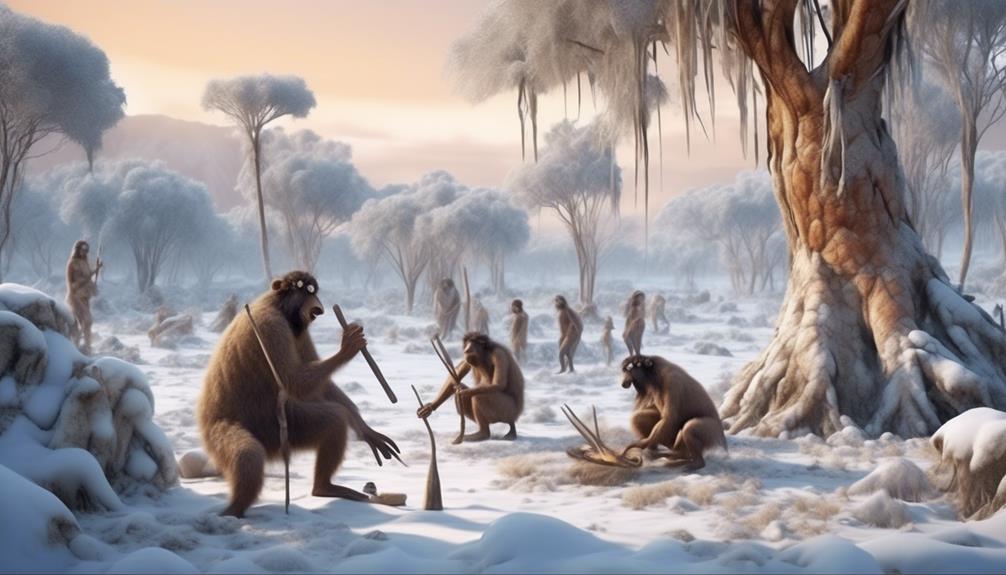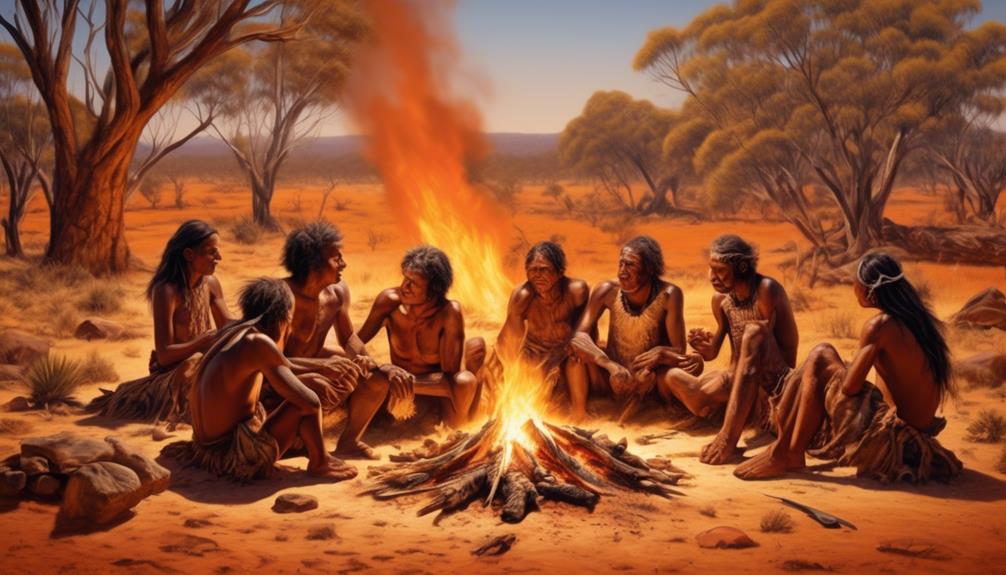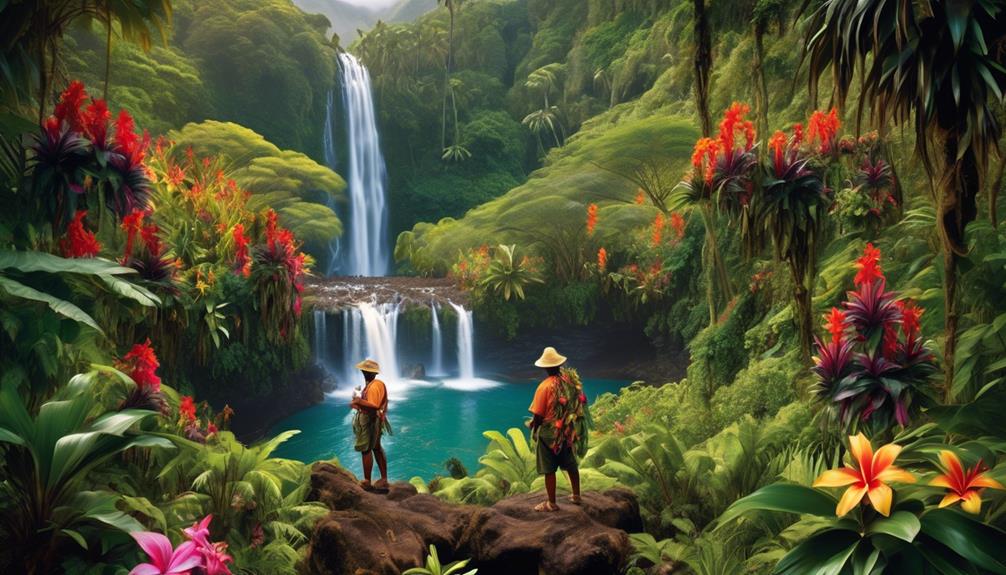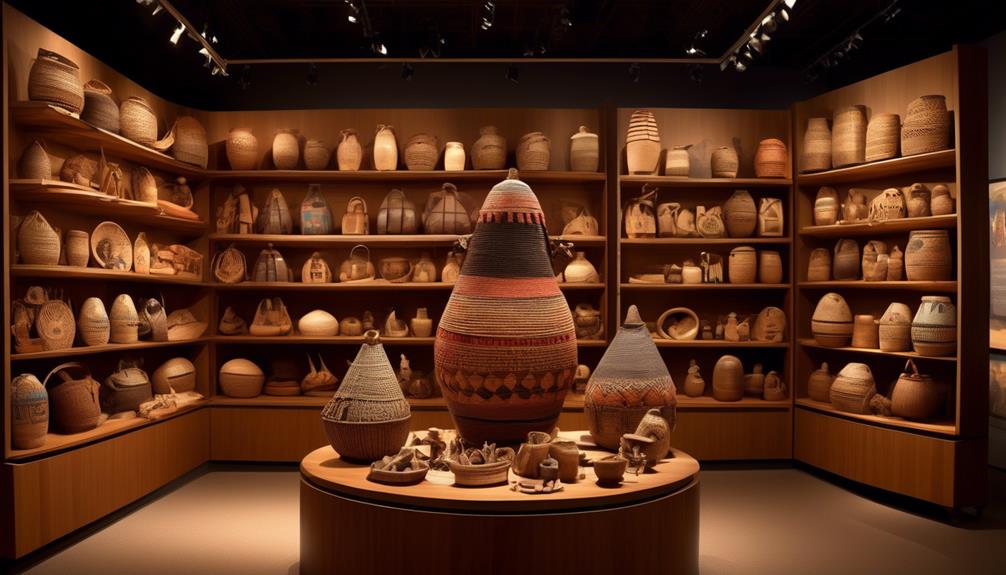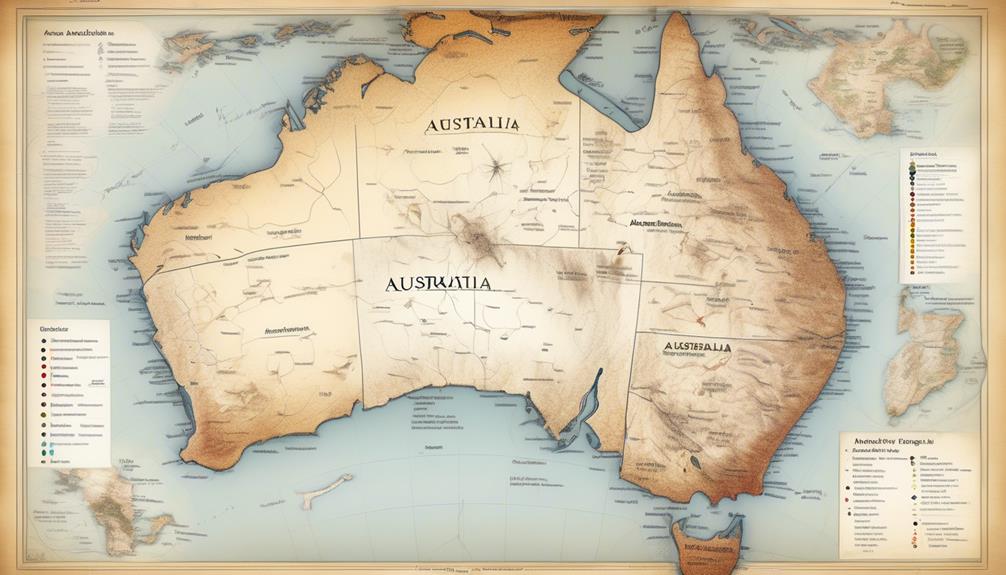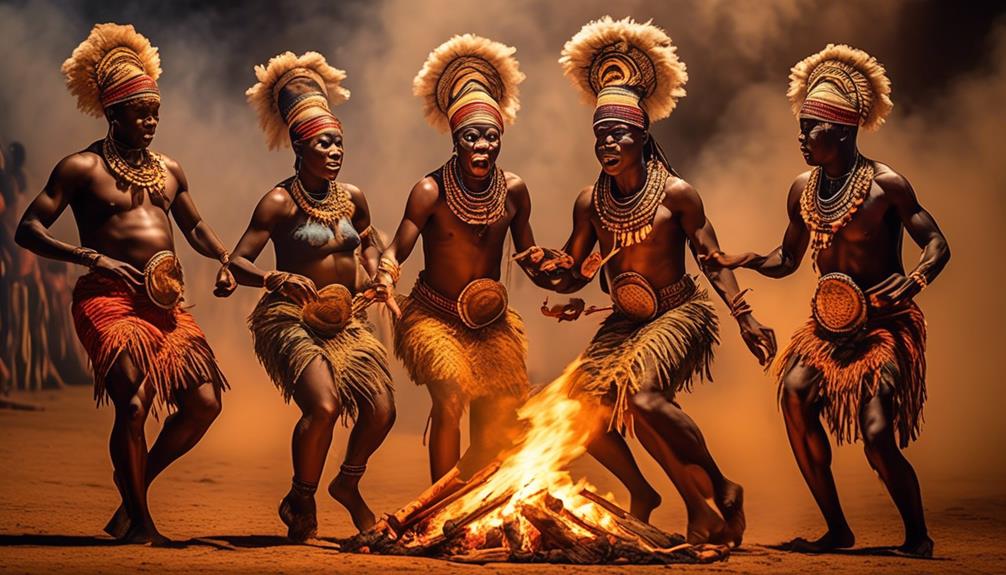When considering the challenges faced by Aboriginal Australians during the last ice age, it is intriguing to explore the archaeological evidence revealing their remarkable adaptation strategies. Excavations in the Lake Mungo region have revealed tools and traces of hearths that provide valuable insights into how ancient Indigenous communities coped with the difficult environmental conditions.
However, these findings only scratch the surface of a much deeper and more nuanced story of survival and resilience. Understanding the intricate ways in which Aboriginal Australians navigated the last ice age not only sheds light on their historical experiences but also offers relevant perspectives on the impact of climate change on modern Indigenous communities.
Key Takeaways
- Aboriginal Australians faced challenges such as harsh environmental conditions and resource scarcity during the last Ice Age.
- They developed sophisticated knowledge of the land and implemented diverse diets to navigate resource scarcity effectively.
- Archaeological evidence reveals adaptation strategies such as nomadic lifestyles, tool innovation, hunting and gathering techniques, shelter construction, and social organization.
- Indigenous perspectives highlight the importance of a deep connection to the land, cultural resilience, community cooperation, and sharing of knowledge for survival and resilience.
Ice Age Challenges Faced by Aboriginal Australians
During the Last Ice Age, Aboriginal Australians faced significant challenges in adapting to the harsh environmental conditions and resource scarcity. The environmental changes during this period forced Aboriginal Australians to develop innovative adaptation strategies to ensure their survival.
With the onset of the Ice Age, the landscape transformed, leading to a decrease in available resources such as food and water. In response, Aboriginal communities implemented various strategies to cope with these challenges. They diversified their diets by incorporating a wide range of plant and animal species, allowing them to adapt to the changing availability of resources.
Additionally, they developed sophisticated knowledge of the land, enabling them to identify sustainable food sources and water supply locations. Through communal cooperation and sharing of resources, they were able to navigate the resource scarcity more effectively.
These adaptation strategies were crucial in enabling Aboriginal Australians to not only survive but also thrive in the face of extreme environmental changes. Their resilience and resourcefulness continue to be a source of inspiration and admiration, showcasing the strength of indigenous communities in overcoming adversity.
Archaeological Evidence Revealing Adaptation Strategies

Archaeological findings vividly illustrate the ingenious adaptation strategies employed by Aboriginal Australians during the Last Ice Age, shedding light on their resourcefulness and resilience in the face of extreme environmental challenges. The evidence reveals compelling insights into how Aboriginal Australians coped with the dramatic environmental changes, showcasing their cultural practices and innovative approaches to survival.
- Mobility: Nomadic lifestyles and seasonal movements allowed for efficient resource exploitation.
- Tool Innovation: Adapting and crafting tools to suit changing environments and resource availability.
- Hunting and Gathering Techniques: Utilizing diverse hunting and gathering techniques to secure food sources in challenging conditions.
- Shelter Construction: Building versatile shelters suited for varying climates and terrains.
- Social Organization: Developing intricate social structures to share knowledge, resources, and responsibilities within the community, ensuring survival.
The archaeological evidence not only highlights the adaptability of Aboriginal Australians in the face of environmental changes but also underscores the importance of understanding and respecting their cultural practices. It's a testament to their deep connection with the land and their ability to thrive within the constraints of the Last Ice Age.
Indigenous Perspectives on Survival and Resilience
Through our indigenous perspective, we offer a profound understanding of the enduring spirit and adaptive resilience of our ancestors during the Last Ice Age. Our indigenous traditions have always been deeply rooted in the land, fostering a profound connection to nature and a keen understanding of its rhythms and cycles.
This connection allowed our ancestors to develop ingenious strategies for survival, drawing upon a rich cultural resilience that has been passed down through generations. Our people possessed a deep knowledge of the land, its resources, and the behaviors of the flora and fauna, enabling them to adapt and thrive in the harsh conditions of the Last Ice Age.
Indigenous perspectives on survival and resilience emphasize the importance of community, cooperation, and sharing of knowledge. Our ancestors understood the significance of solidarity and mutual support, which enabled them to endure and overcome immense challenges. Cultural resilience was woven into every aspect of daily life, from the sharing of traditional ecological knowledge to the passing down of oral histories that preserved valuable lessons from the past.
Our enduring spirit and adaptive resilience during the Last Ice Age serve as a testament to the strength and wisdom of indigenous cultures.
Impact of Climate Change on Ancient Indigenous Communities
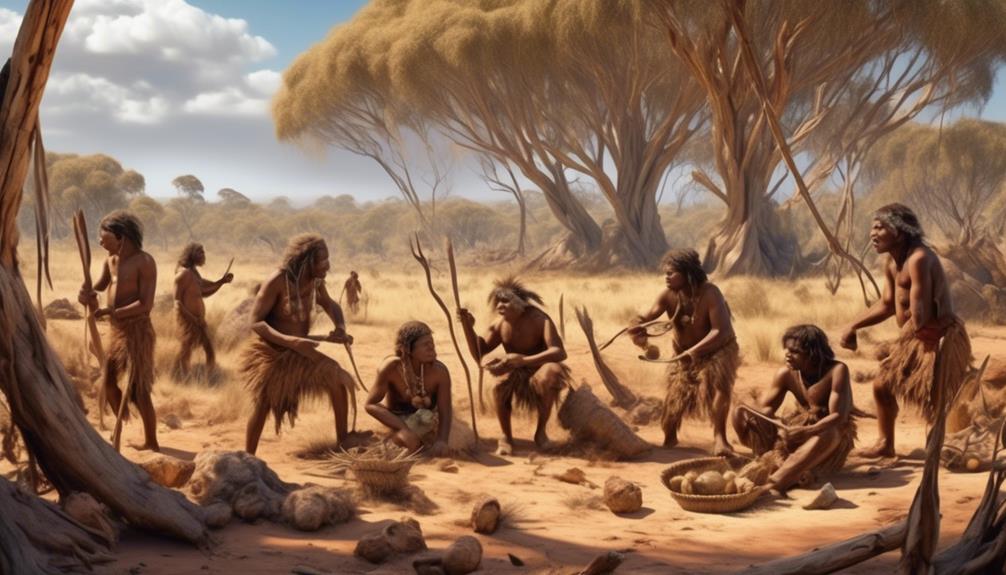
Drawing upon our indigenous tradition's deep understanding of the land and its rhythms, we witness the profound impact of climate change on the ancient indigenous communities. The environmental changes have significantly affected our way of life, compelling us to adapt in innovative ways. Here are some key points to consider:
- Resilience through Traditional Knowledge: Our ancestors' wisdom and traditional knowledge have enabled us to develop adaptation strategies that are deeply rooted in our cultural practices.
- Shifting Resource Availability: Climate change has led to the alteration of resource availability, challenging our traditional means of sustenance and necessitating new approaches to food and water sourcing.
- Cultural Practices and Rituals: Environmental changes have influenced the timing and nature of our cultural practices and rituals, requiring us to modify and adapt these essential elements of our identity.
- Community Cooperation and Support: In the face of environmental uncertainties, our communities have come together to support one another, fostering a sense of unity and shared responsibility.
- Sustainable Land Management: We've embraced sustainable land management practices, drawing from ancient wisdom to ensure the preservation and health of our environment for future generations.
These factors underscore the profound impact of climate change on ancient indigenous communities, highlighting the importance of understanding and supporting these communities as they navigate these challenges.
Contemporary Relevance of Aboriginal Survival Techniques
In our contemporary context, the traditional survival techniques of Aboriginal Australians continue to demonstrate remarkable efficacy and adaptability in navigating modern challenges. Indigenous innovation, rooted in deep understanding of the land and environment, offers valuable lessons for today.
The ways in which Aboriginal Australians have historically sourced food, medicine, and water hold modern application, especially in the face of climate change and environmental degradation. Their intimate knowledge of the land has allowed them to thrive for thousands of years, and this knowledge remains relevant today.
Modern society can learn from the sustainable practices of Aboriginal Australians, such as the use of controlled burning to manage landscapes, which can help prevent devastating wildfires. Additionally, their holistic approach to health and well-being, incorporating physical, emotional, and spiritual aspects, can offer valuable insights for addressing contemporary health challenges.
Frequently Asked Questions
What Specific Tools and Techniques Did Aboriginal Australians Use to Cope With the Challenges of the Last Ice Age?
We adapted to the challenges of the last Ice Age with a combination of tools, techniques, and cultural practices.
Our social structure and resilience were crucial in coping with the harsh conditions.
We used specialized tools for hunting and gathering, such as spears and boomerangs.
Techniques like controlled burning helped manage the landscape.
Our cultural practices, passed down through generations, provided valuable knowledge for survival in the changing environment.
How Did the Social Structure and Cultural Practices of Aboriginal Australians Contribute to Their Survival During the Ice Age?
Our survival during the ice age was rooted in our social cohesion and traditional knowledge. Our strong social structure allowed us to share resources and support one another, enhancing our resilience.
Additionally, our cultural practices and deep understanding of the environment enabled us to adapt and thrive in challenging conditions. These factors combined to create a powerful framework for our survival and adaptation during the last ice age.
What Evidence Exists to Suggest That Aboriginal Australians Had Knowledge of Climate Change and Its Impact on Their Communities During the Ice Age?
We have evidence of Indigenous knowledge and survival techniques that suggest Aboriginal Australians had a deep understanding of climate change impact.
Cultural practices, scientific advancements, and environmental challenges all played a role in their ability to cope with the Last Ice Age.
This knowledge was vital for the survival of Indigenous communities, demonstrating their resilience and adaptability in the face of significant environmental changes.
How Have Modern Scientific Advancements Helped to Further Understand the Resilience and Survival Techniques of Aboriginal Australians During the Ice Age?
Modern scientific advancements have unlocked new insights into the resilience and survival techniques of Aboriginal Australians during the ice age.
By studying ice age tools and analyzing evidence of social structure, researchers have gained a deeper understanding of how Aboriginal communities coped with harsh environmental conditions.
These discoveries not only showcase the resourcefulness of Aboriginal people but also highlight the importance of their knowledge in adapting to and thriving in challenging environments.
What Parallels Can Be Drawn Between the Survival Strategies of Aboriginal Australians During the Ice Age and Contemporary Environmental Challenges Faced by Indigenous Communities?
We see parallels between the survival strategies of Aboriginal Australians during the ice age and contemporary environmental challenges faced by indigenous communities.
Indigenous resilience and environmental adaptation both involve deep connections to the land, sustainable resource management, and traditional knowledge.
These parallels highlight the ongoing strength and wisdom of indigenous cultures in navigating environmental changes, offering valuable lessons for addressing current environmental challenges with respect for traditional wisdom and sustainable practices.
Conclusion
As we continue to uncover the incredible resilience and survival techniques of Aboriginal Australians during the last Ice Age, we're left in awe of their adaptability and resourcefulness.
The archaeological evidence and indigenous perspectives shed light on their remarkable ability to thrive in challenging environments.
This knowledge not only enriches our understanding of history, but also prompts us to consider the contemporary relevance of their survival strategies in the face of ongoing climate change.
Mary is a passionate writer who brings creativity and a fresh perspective to our team. Her words have the power to captivate and inspire, making her an essential contributor to our content. Mary’s commitment to storytelling and dedication to promoting Indigenous culture ensures that her work touches the hearts of our readers. We’re fortunate to have her as part of our team.
